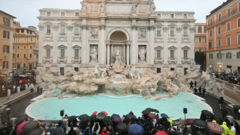The Trevi Fountain, one of Rome's most cherished landmarks, has officially reopened after a three-month restoration aimed at enhancing its splendor and managing the ever-present throng of tourists.
Revitalized Trevi Fountain Reopens with New Queue System to Manage Tourist Crowds

Revitalized Trevi Fountain Reopens with New Queue System to Manage Tourist Crowds
Rome implements measures to regulate the flow of visitors at the iconic Trevi Fountain following its restoration.
The baroque masterpiece, originally crafted in the 18th century by architect Nicola Salvi, attracts between 10,000 and 12,000 daily visitors. To create a more enjoyable experience, Rome's Mayor Roberto Gualtieri has introduced a new queuing system to mitigate overcrowding around the fountain. During the reopening ceremony, which took place on a rainy Sunday, hundreds of tourists participated in the age-old tradition of tossing coins into the fountain while the mayor emphasized the importance of this initiative in providing a more serene visit.
The restoration project, completed in time for the upcoming jubilee celebrations of the Roman Catholic Church, involved extensive cleaning efforts—removing mold and calcium buildup from the historic structure. In addition to the new queuing system, local officials are contemplating a modest entry fee to aid in the ongoing maintenance of the fountain.
Historically, the Trevi Fountain has served as a symbolic waypoint of Rome's aqueducts, particularly the Acqua Vergine, which spans 20 kilometers. Following a harsh winter in 2012 that caused structural damage, the fountain underwent significant renovations funded by the revenue collected from coins cast by visitors, generating around €10,000 weekly for local charities.
Besides enhancing its aesthetic appeal, this restoration project and the new visitor management strategies aim to preserve one of Rome’s greatest cultural treasures while ensuring that every visitor experiences the enchantment of the Trevi Fountain in comfort.
The restoration project, completed in time for the upcoming jubilee celebrations of the Roman Catholic Church, involved extensive cleaning efforts—removing mold and calcium buildup from the historic structure. In addition to the new queuing system, local officials are contemplating a modest entry fee to aid in the ongoing maintenance of the fountain.
Historically, the Trevi Fountain has served as a symbolic waypoint of Rome's aqueducts, particularly the Acqua Vergine, which spans 20 kilometers. Following a harsh winter in 2012 that caused structural damage, the fountain underwent significant renovations funded by the revenue collected from coins cast by visitors, generating around €10,000 weekly for local charities.
Besides enhancing its aesthetic appeal, this restoration project and the new visitor management strategies aim to preserve one of Rome’s greatest cultural treasures while ensuring that every visitor experiences the enchantment of the Trevi Fountain in comfort.





















